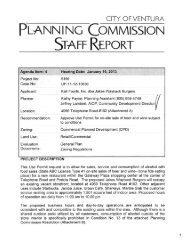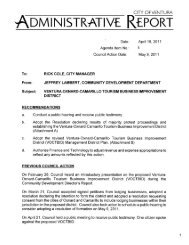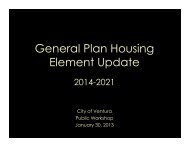Saticoy & Wells Community Plan & Development ... - City Of Ventura
Saticoy & Wells Community Plan & Development ... - City Of Ventura
Saticoy & Wells Community Plan & Development ... - City Of Ventura
Create successful ePaper yourself
Turn your PDF publications into a flip-book with our unique Google optimized e-Paper software.
<strong>Saticoy</strong> & <strong>Wells</strong> <strong>Community</strong> <strong>Plan</strong> and Code EIRSection 4.8 Hydrology and Water QualityAction 11.5.6Policy 11NRequire new development to either pay their proportionate share for orconstruct specific improvements identified in the updated <strong>Saticoy</strong> and<strong>Wells</strong> Capital Improvement Deficiency Study.Develop a rich and interconnected palette of public open spaces in aninspirational manner that facilitates social interaction and a sense ofcommunity, and provides ecoservices such as planned sub-basin drainageand storage.Action 11.6.11 Create multi-functional parks and open space that benefit people and theenvironment by protecting and enhancing water supplies, and providingflood and storm water management services.Action 11.6.12 Identify opportunities to use and connect public lands such as playingfields, parks, and rights-of-way for “green solutions” to water quality andsupply problems, while creating a more human urban environment.<strong>Development</strong> facilitated by the Project would require increases in the number or size ofstormwater collection lines, and may require new or expanded recharge infrastructure (i.e.,basins or injection wells). The larger vacant and agricultural parcels that could be converted tosuburban use under the Project (the UC Hansen site, the Parklands site, the Broome Site, andCitrus Place) include sufficient acreage to allow for provision of onsite detention or retentionfacilities. Where infill of vacant parcels occurs, localized runoff could increase incrementally.However, such increases can be addressed on a case-by-case basis and individual developerswould be required to implement solutions to address their project’s impacts. Even with limitedacreage, on-site solutions, such as detention facilities constructed under parking lots and/orutilization of impervious paving methods, could be employed to minimize runoff.In the event that on-site solutions are unavailable, individual developers may contribute to thefunding of regional solutions, such as off-site detention basins and/or drainage facility capacityenhancement projects. This would be required under <strong>Community</strong> <strong>Plan</strong> Policy 11L actions11.5.4, 11.5.5 and 11.5.6. It is anticipated that potential regional impacts to the local drainagesystem can be reduced to a less than significant level through implementation of applicable <strong>City</strong>and Watershed Protection District regulations on a case-by-case basis. Implementation of theapplicable regulatory requirements and proposed <strong>Community</strong> <strong>Plan</strong> actions would reducepotential impacts to groundwater recharge to a less than significant level and, in someinstances, may improve recharge as compared to current conditions. It is also anticipated thatimplementation of storm drain system improvements in accordance with current requirementsand the Project’s actions would not have significant secondary environmental effects and wouldgenerally reduce pollutants in storm runoff. <strong>Development</strong> facilitated by the Project would berequired to comply with the most recent NPDES requirements at the time of developmentapproval.Implementation of the applicable regulatory requirements, in combination with the 2005General <strong>Plan</strong> actions and the proposed <strong>Community</strong> <strong>Plan</strong> actions would reduce impacts tosurface runoff to a less than significant level.4.8-10<strong>City</strong> of <strong>Ventura</strong>
















